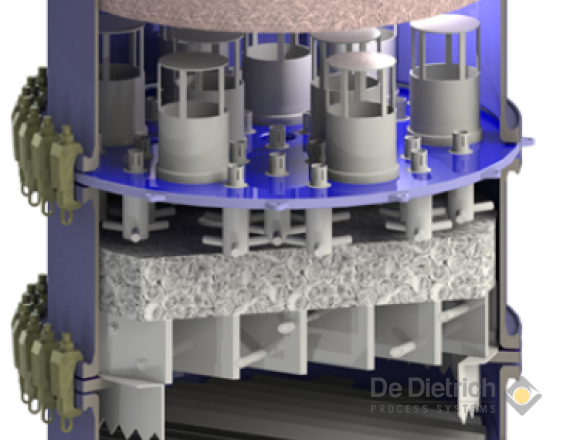Process solutions for thermal separation



Highlights
- Corrosion-resistant materials for corrosive substances
- Vacuum and pressure-resistant for a wide variety of process conditions
- Temperature ranges up to +230°C
- Diffusion-proof for sustained corrosion resistance
- Smooth surfaces that stay clean, non-stick effect
- Abrasion-resistant for a long service life
- Compact design to keep investment costs down
- Reliable process design for further investment cost reduction
- Solutions optimised for efficient processes
- From initial design to component manufacturing to commissioning – from a one-stop shop
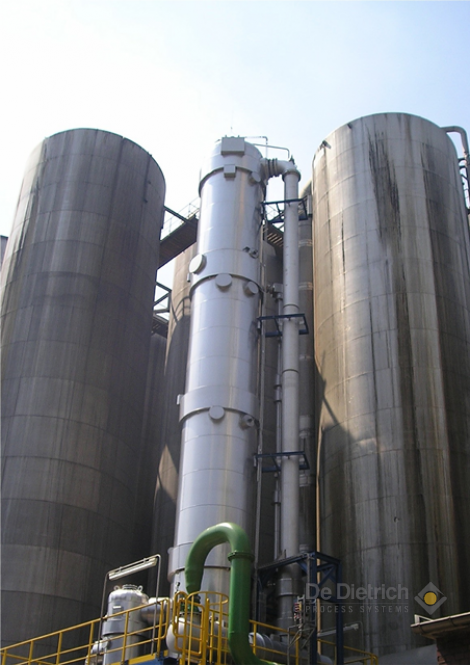
Concept
Optimal solutions using separation columns for highly corrosive processes
Thermal separation processes are often used in treating and cleaning chemicals. Very common are processes that involve two liquids or a liquid and a gas. The processes used mainly involve extraction, absorption, desorption or stripping, distillation or rectification as shown in enclosed scheme. These separation processes require mass transfer between two phases; in the above rectification example, the mass transfer between the liquid and gas phase. Keeping the equipment used in this process as compact as possible requires creating as much mass transfer surface in as small volume as possible, which involves columns with specialised internals in thermal process engineering.
The process core in the columns consists of packings that provide the mass transfer surfaces; these involve specialised trays such as bubble-cap or sieve trays as well as random or structured packing. Especially for random and structured packing and in addition to support trays further internal components are required to wett all surfaces equally for optimum mass transfer. These additional components include liquid distributors that evenly distribute the incoming fluid over the column cross-section, and wall wipers to deflect liquid from the wall inside the column back into the packing. Further internal components are needed to control the liquid flow out of the column; demisters reliably restrain droplet drift at the upper end of the column, while collectors underneath the packing catch the reflux liquid, either removing the liquid from the column or feeding it back to a redistributor. Vortex breakers and collectors at the lower end of the column ensure reliable liquid drainage. For optimum process performance the designs and materials vary widely for differnent processes and nominal column widths. These constructions have been developed over decades and have proven their worth in our QVF® processes.
We would be pleased to design a column and select internal components optimised for your application.
From basic engineering to start-up, we provide everything from a one-stop shop.
Rectification column diagram
- Demister, mist eliminator
- Liquid distributor
- Packing
- Support grid
- Wall wiper, funnel
- Collectors and redistributor
- Structured DURAPACK® packing
- Wall wipers around the packing
- QVF® CORE tray
- Steam inlet
- Vortex breaker, outlet collector
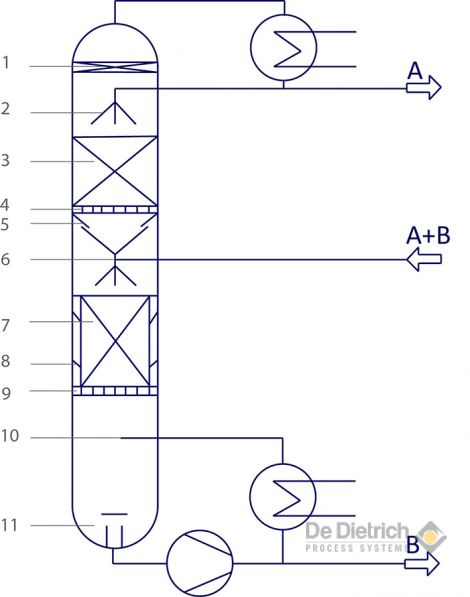
Columns
Glass columns up to DN1000 – glass-lined columns up to DN2400
We deliver QVF® columns in borosilicate glass 3.3 up to DN1000 and De Dietrich® glass-lined steel columns up to DN2400. Our columns operate at temperatures ranging between -60° and +230°C. We design QVF® glass columns and De Dietrich® glass-lined steel columns according to the 2014/68/EU (97/23/EC) according to AD-2000 or DIN/EN-13445) pressure vessel standards and directives for the European market, and the standards applicable such as ASME VIII Div.1 for the USA or SQL for the Chinese market for glass-lined columns. QVF® glass columns according to EN1595 are approved for pressures between -1 and +1barg, and De Dietrich® steel and glass-lined columns are usually approved for pressures between -1 and +6barg. We also supply columns for extended application scenarios on request.
Glass column DN800 Glass-lined steel column DN2300
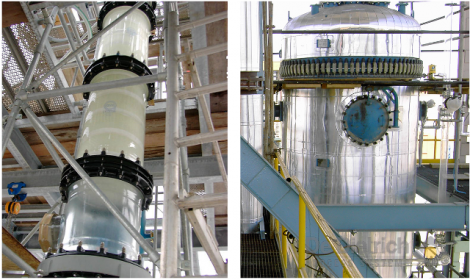
Both materials used – De Dietrich® DD3009 glass-lining and QVF® borosilicate glass 3.3 – are extremely resistant against acids, providing a cost-effective and temperature-resistant alternative to special metallic materials and non-vacuum-resistant PTFE-lining.
The surfaces of both materials are inert and extremely smooth, cutting the risk of caking while facilitating the cleaning process. Both materials are catalytically inert and neutral to taste.
Manufacturing a column section in glass-lined steel / shop fabrication in borosilicate glass 3.3
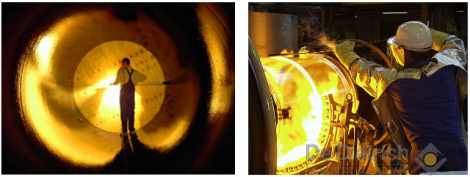
Our unique manufacturing process ensures leading global tolerance accuracy in smoothness, straightness and roundness. Glass-lined columns are available at tolerances to ½ DIN 28007-T2 on request. Our glass-linings fulfill current standards such as ISO 28721-1 on quality and quality assurance.
The tray, liquid distributor and collector heights in addition to column section heights for the random or structured packing play an essential role in overall column height, which is often restricted to certain total for structural reasons. We manufacture segments at max. 5.5m height for glass-lined columns that can reach a overall height of 52m.
Bubble-cap trays
Solution for a wide range of loads
We have developed bubble-cap trays in borosilicate glass 3.3 and PTFE for glass columns from DN200 to DN600; these trays operate at constant separation efficiency over a wide range of loads. The liquid level on the trays can be adjusted by design, ensuring that the column will still operate at the lowest gas loads or as a reaction column.
Bubble cap-tray column diagram / installaing a PTFE bubble-cap
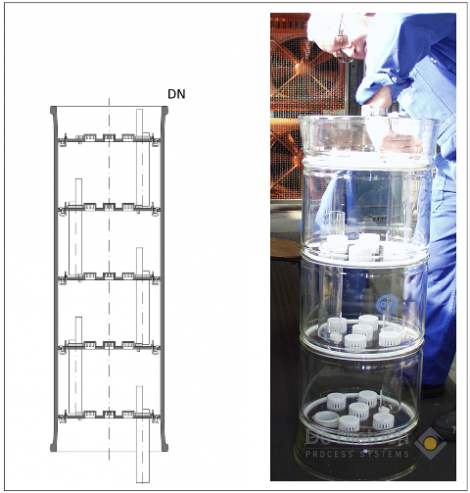
Packing
Compatibility guaranteed
We would be happy to select the ideal packing for your application from the market. Temperature and corrosion-resistant QVF® Raschig rings in borosilicate glass 3.3 and any other type or material from other manufacturers are used depending on operating conditions with the corresponding column process engineering for the purpose.
Glass column with polymer packing / with glass Raschig rings
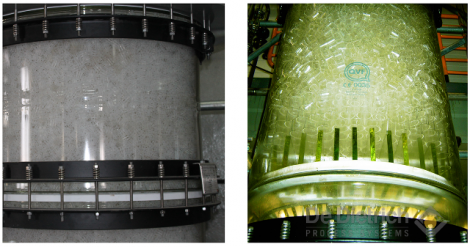
Structured packing
High separation efficiency, low pressure drop
Our structured DURAPACK® packing in borosilicate glass 3.3 is ideal for corrosion-resistant glass 3.3 or glass-lined steel columns, as it has the same corrosion resistance as the glass column and keeps its thermal stability at higher temperatures compared to polymers. Borosilicate glass 3.3 is non-porous, substantially cutting erosion and corrosion compared to equivalent ceramic packing. The high number of possible trays gives you the ideal packing for corrosive separation applications, especially in vacuum pressure ranges, due to the low pressure drop. Packing elements are segmented from DN450 for installation in columns of any diameter. The maximum stack height per support grid is usually 3 metres in glass columns and 5 metres in glass-lined columns.
Please ask for our separate DURAPACK® data sheet.
DURAPACK element / DURAPACK high efficency surface structure
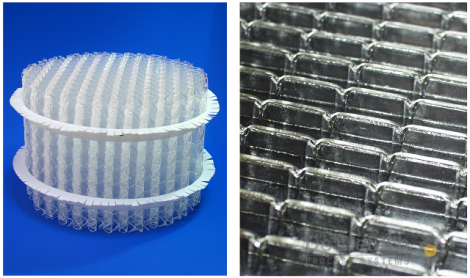
Separation efficiency using DURAPACK® Pressure drop of DURAPACK®
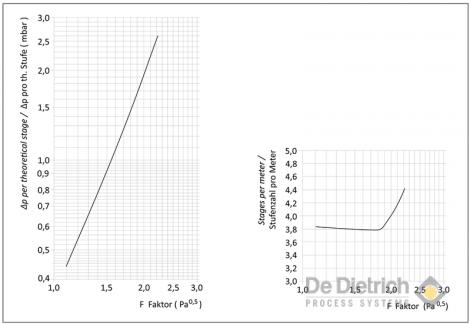
Wall wipers / guiding funnels
PTFE strips to boost efficiency
Liquids tend to collect and flow down on the inner wall of column fitted with packing, an effect that prevents the liquid from wetting the packing surface and keeps most of it out of the mass transfer process. This reduces the efficiency of the column what means that the liquid should be returned into the packing from the wall at regular intervals to restore the system’s efficiency. We have developed PTFE wall wipers and guiding funnels that either are fixed between the column sections or surround the structured packings in bands.
Packing and guiding funnel in a column / DURAPACK® PTFE wall wiper
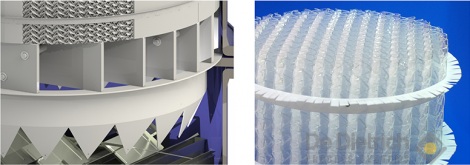
Support grids
Glass to carry the whole load securely
Depending on the packing and nominal width, we use either QVF® support grids in borosilicate glass 3.3 or QVF® CORE trays.
QVF® glass columns have molten-in support- rings to carry the glass grids.
Either glass-lined intermediate rings or vacuum-resistant support rings with metallic cladding are fitted into glass-lined steel columns, depending on the column’s dimensions.
Glass-lined column support grid / Borosilicate glass 3.3 support grid
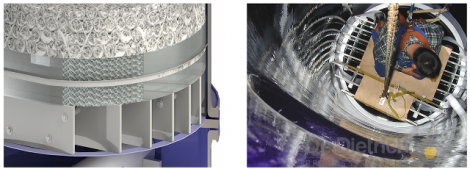
Patented QVF® CORE-Trays
Glass cylinders support the packing
This is an especially and effective support for structured packing as it retains most of cross-sectional area for the gas flow, thus keeping the pressure drop down. Drained liquids and rising gases flow past one another, keeping the gases from blocking run-down liquid and eliminating the resulting limit on maximum flow rate. The drain outlets of the QVF® CORE-Trays for the liquid are equipped with varying PTFE or borosilicate glass 3.3 elements depending on liquid load so that these trays serve for an extremely compact redistributor.
DN1000 QVF® CORE-Tray / QVF® CORE-Tray diagram

Liquid distributors
Uniform wetting for any load
Depending on the size and the properties of the material of construction different designs for liquid distributors have been developed. We use QVF® borosilicate glass 3.3, De Dietrich® glass-lined steel, SiC, PTFE, PVDF, and corrosion-resistant metals such as Tantalum, Zirconium and Titanium. The droplet density is determined by the process so that for the a given column diameter different types of liquid distributors have to be realized. We achieve this using different types such as channel-type, tube-type, nozzle-type, and our patented QVF® CORE Tray distributors. Hence there is a huge variety of liquid distributors to select from, we will choose the ideal solution for your process.
QVF® CORE Tray inside column / shop fabrication DN1000 QVF® CORE Tray
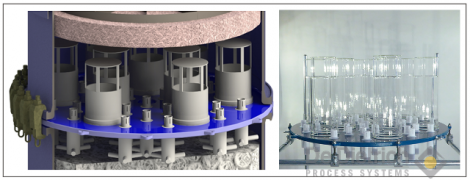
QVF® CORE-Tray distributors are a special solution in corrosion-resistant design as they guide rising gases past draining liquids and keep uprising gases from blocking the downcoming fluid flow, and hence avoiding the column to flood.
This solution is a combination of perforated trays, cylinders with openings for the gaseous phase, and drainage aids for the liquid.
Trays come in borosilicate glass 3.3, glass-lined steel, or metal-cladded such as Tantalum, Zirconium or Titanium, depending on nominal column width and type. Borosilicate glass 3.3 cylinders come in different designs with different openings for the gaseous phase depending on their function as feed trays, packing support or redistributors; drainage aids are available in borosilicate glass 3.3 or PTFE and in various designs depending on the amount of liquid to be distributed.
QVF® CORE trays are clamped between column sections, and only increase the maximum height of the column to a minimal degree. This affects also the total hight of your production building and the cost for this invest.
Other distributor types such as glass tube distributors, glass channel distributors or special metallic distributors are selected depending on process specification.
DN450 glass channel distributor / Channel distributor in operation
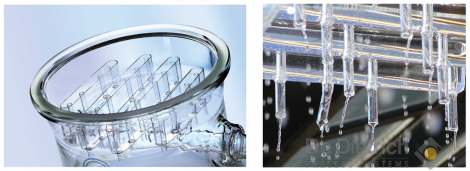
SiC Channel Distributors
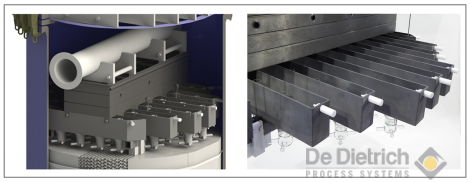
Collectors
Reliable side drainage
Collectors are usually combined with a liquid redistributor to keep column heights and costs down, but standalone collectors also serve to drain liquid off in a side flow. We manufacture collectors in borosilicate glass 3.3 for columns up to DN1400, or alternative materials such as Tantalum or SiC for columns with wider nominal diameters.
Collector in a glass-lined column / Borosilicate glass 3.3 collectors
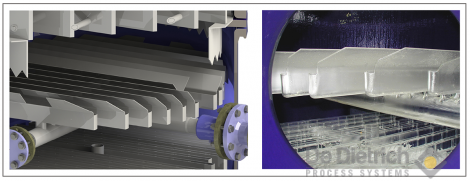
Demisters and mist eliminators
No droplet entrainment
Demisters or mist eliminators at the head of the column prevent droplet entrainment at the upper end of the column. Demisters might be additional packing or fibers in inert materials; perfluorinated hydrocarbons PFA and ETFE have proved particularly suitable for highly corrosive applications. Mist eliminators using fibers also save costs and space, and are fastened to several type of supporting structures inside the column.
Demister at the head of the column / Demister with ceramic support
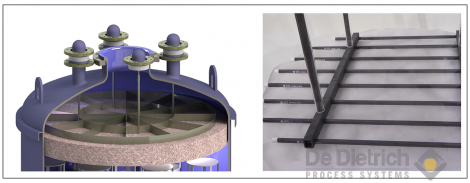
Vortex breakers, outlet collectors, vapour-inlet
Relyable draining for a relyable operation
For processes such as absorption, desorption and stripping usually relatively large quantities of liquid have to be drained off from the bottom of the column, possibly using a pump or natural flow. Special metallic liquid collectors at the bottom of the column have proven their worth, while also serving as centrally or eccentrically arranged PTFE-vortex breaker preventing gas from being fed into the nozzle. These vortex breakers also allow solids, from abrasion from equipment such as ceramic packing, to settle before they reach downstream equipment.
Run-down liquid needs to be kept away from entering into the vapour or gas-inlet nozzles. A vapour inlet pipe feed the vapours equally over the cross-area of the column, increases the efficiency of the packing and hence reduces the overall height of the column.
Column bottom part with several internals
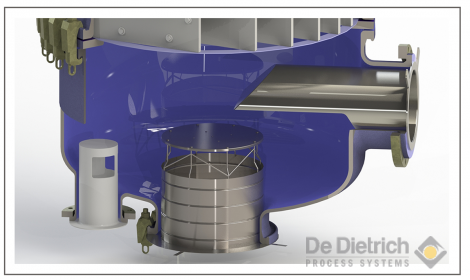
Concept - design - engineering – implementation
One-stop shop, quality in one hand
We have decades of experience in supplying column systems for thermal separating processes, especially those involving highly corrosive media like acids. We design and manufacture the main components according to national and international quality standards and directives. The separation processes have been developed in our own test hall. Hence we have our own high expertise in designing separation processes and, if requested, we will provide process guarantees. We would be pleased to engineer for you based on a computer simulations the most suitable column for your application, an optimum solution to operate your process reliable and efficient.
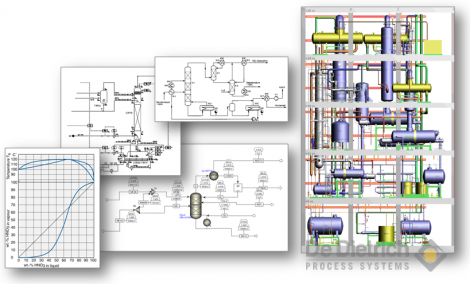
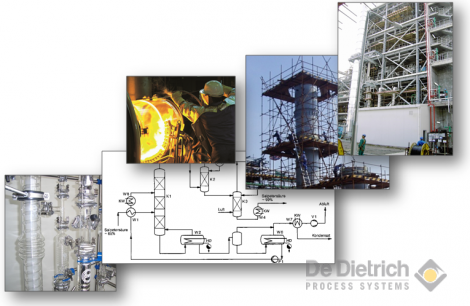
QVF® Processes
Systems for highly corrosive process applications
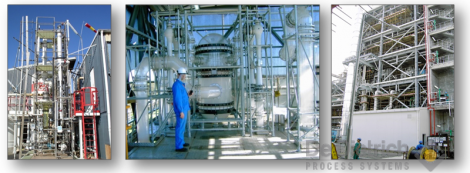
| H2SO4 | Recovery |
| HNO3 | Concentration |
| HCl | Cleaning |
| Denitration | |
| Concentration | |
| Dilution |
| Br2 and bromides | Production |
| Cl2 and chlorides | Cleaning |
| l2 and iodides | Removal |
| Recovery | |
| Removal | |
| Recovery |
| NOx | Conversion |
| SO2 and SO3 | Absorption |
| HCl and Cl2 | Reduction |
| Removal | |
| Cleaning |
and a lots of other processes.
Please don’t hesitate to contact us for more details!
Applications

